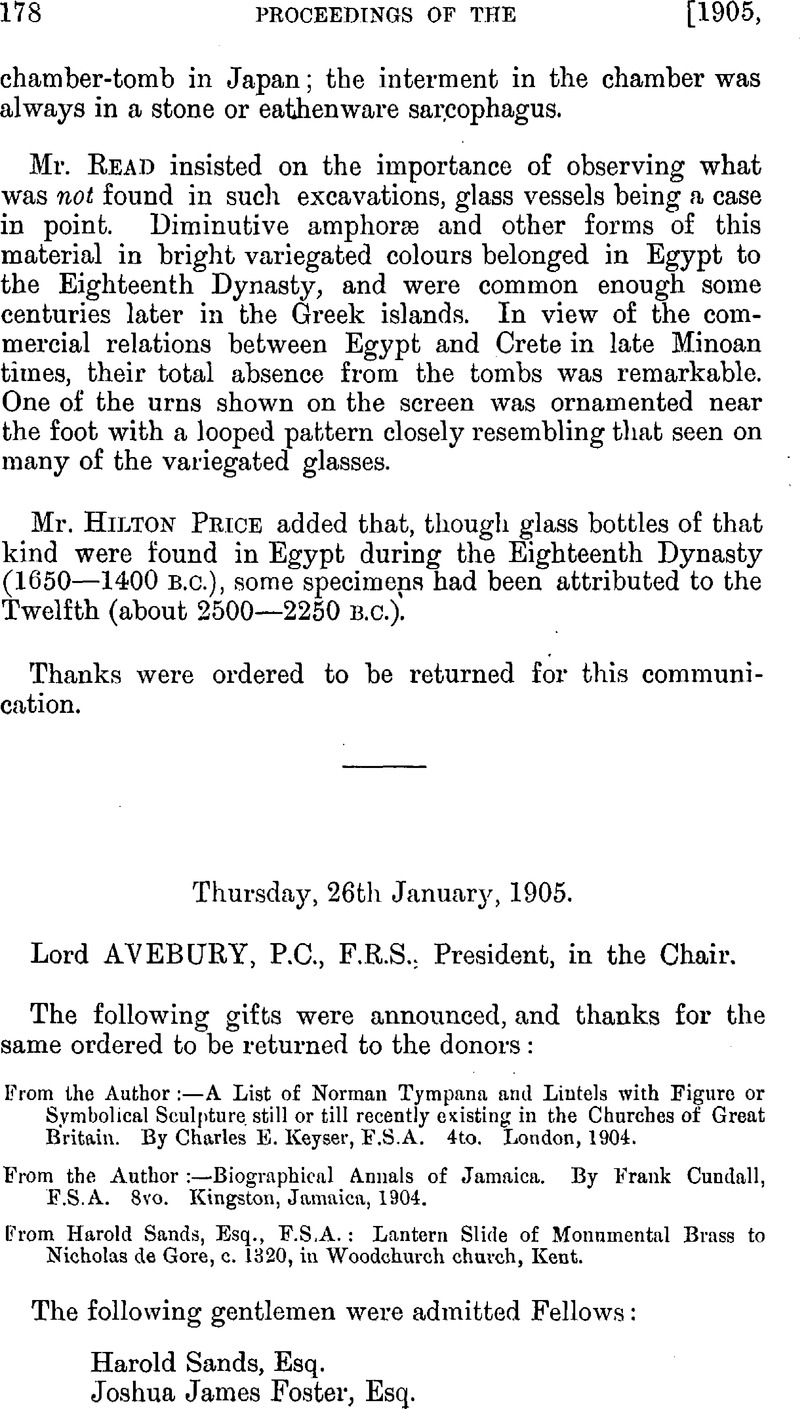No CrossRef data available.
Published online by Cambridge University Press: 10 May 2010

page 180 note * See also Archaeologia, xlv. 263.
page 180 note † Supplément au recueil d'antiquités suisses (1860), pl. xii. figs. 1, 2; more than sixty were found, with an average length of 30–34 cm. = 12–13½ in., the heaviest weighing more than 3½ lbs.
page 180 note † In reply to an inquiry, Dr. L. Lindenschmit informs me that the average weight of the ingots from Bechtheim is between 6 and 7 kilos.
page 180 note § Proceedings, 2nd S. xvii. 25.
page 180 note ‖ Proceedings, 2nd S. viii. 314.
page 181 note * E. Vouga, Les Helvètes à La Tène, pl. xii. fig. 11 ; V. Gross, La Tène, pl. viii. fig. 8.
page 182 note * Collectanea Antiqua, vi. pl. ii. figs. 2, 3.
page 182 note † Collectanea Antiqna, iv. pl. xvi. p. 67 ; cf. vol. vi. p. 5.
page 184 note * 1886, pl. iii. fig. 4, p. 82.
page 183 note † Archæological Journal, i. 165 and fig.
page 183 note ‡ Skelton, Ancient Armour at Goodrich Court, pl. xlv. fig. 3.
page 183 note § Proceedings, 2nd S. i. 233.
page 183 note ‖ Collectanea Antiqua, vi. 6.
page 183 note ¶ Proc. Oxford Archit. and Hist. Soc. i. 5.
page 184 note * Catalogue of Museum formed at Worcester: Archæological Institute, 1862. p. 13.
page 184 note † 2nd S. viii. 313.
page 184 note ‡ Associated Societies' Reports, xviii. 60, pl. iii. fig. 4.
page 185 note † The handles of those so marked are imperfect.
page 185 note * This specimen, from the Roach Smith collection, is heavily coated with wax.
page 185 note ‡ vol. i. 1836–7.
page 185 note § Tor weights, see Ridgeway, Origin of Metallic Currency, Appendix.
page 185 note ‖ Numismatic Chronicle, i. 13.
page 186 note * Journal of the British Archæological Association, i. 226.
page 186 note † Add. MS. 10,084, fol. 27b.
page 187 note * It is thought that bronze coins wore not struck in Britain boforo Cæsuar's invasion.
page 187 note † A specimen found on the site is figured in Revue Archéologique, N. S. iv. (1861), pl. xiii. fig. 20.
page 187 note ‡ The find at Neath was probably not a founder's hoard, most of the objects being in good condition; but pieces of rough copper were included and may have been used as bullion. Cakes of copper dating from the Roman period have been found at the Parys Mine, Anglesey, in Kent, and elsewhere.
page 188 note * Collectanea Antiqua, vi. 11; Wright, Celt, Roman, and Saxon, 291.
page 188 note † Epist. ad Familiares, vii. 7 ; Epist. ad Atticum, iv. 16. The question is fully discussed by Sir John Evans, Coins of the Ancient Britons, p. 19.
page 189 note * Presented by Dr. Bickerton Edwards to the Cardiff Museum, and illustrated in Arehæologia Cambrensis. 6th S. v. 144.
page 189 note † The Roman as or libra weighed 5,050 grains.
page 190 note * Zeitschrift des Vereins zur Erforschung der rheinischen Geschichte. und Altertümer in Mainz, vol. iv. parts 2, 3, p. 253, no. 144. The illustration shows three unexplained characters above the I.
page 190 note † The Phœnician (and probably Carthaginian) mina was 11,500 grains (Cornish, Concise Dictionary, p. 764, table xi. and p. 491).
page 191 note * See an illustrated paper by Colonel R. C. Temple on “The Beginnings of Iron Currency,” in Journal of the Anthropological Institute, N.S. ii. (1899), 99
page 191 note † G. F. Hill, Handbook of Greek and Roman Coins, 7.
page 191 note ‡ Lysander, cap. 17 ; for arguments against this etymology, see Robert Hussey, Essay on Ancient Weights and Measures, 182.
page 191 note § Ridgeway, op. cit. 310.
page 191 note ‖ ![]() Ridgeway, op. cit. 214 ; Hill, op. cit. These seem to have been found ; Waldstein, The Angive Heraeum, i. 62, 77, fig. 31.
Ridgeway, op. cit. 214 ; Hill, op. cit. These seem to have been found ; Waldstein, The Angive Heraeum, i. 62, 77, fig. 31.
page 192 note * Dr. Arthur Evans, Archæologia, lii. 342 (vase at Mayence), and 388 (The Rhine route).
page 192 note † Herodian (fl. 238), xxxiii. c. 2 ; Mon. Hist. Brit. p. lxiv.
page 192 note ‡ Smith's Dictionary of Antiquities, 1882 ed., 932.
page 192 note § Another view is taken by F. W. Cornish, Concise Dict, of Greek and Roman Antiquities, 492, 764 ; Æginetan and Attic commercial mina = 9,750 grains ; Euboic,.6,500 grains : Solonian, 6,700 grains.
page 192 note ‖ Corp.Inser., No. 123, § 4, vol. i. p. 164 ; Public Economy of the Athenians (trans. Lamb), 1857, pp. 28, 32.
page 193 note * Smith's Dictionary of Antiquities, 3rd edition. 1891, p. 452.
page 193 note † See illustration, op. cit. 355 ; Hill, op. fit. 156.
page 193 note ‡ Illustrations in Arehaeologia, xli. pl. xxi. p. 466 ; Jewitt's Reliquary, iv. 121 ; Camb. Antiq. Soc. Communications, iv. 129.